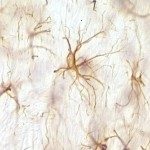Link to Pubmed [PMID] – 11342668
J. Immunol. 2001 May;166(10):6423-9
A 50-kDa protein was purified as a potential receptor, using an affinity matrix containing biotinylated F14.6 or H9.3 anti-DNA mAbs derived from autoimmune (New Zealand Black x New Zealand White)F(1) mouse and membrane extracts from cells. This protein was identified as calreticulin (CRT) by microsequencing. Confocal microscopy and FACS analysis showed that CRT was present on the surface of various cells. CRT protein was recognized by a panel of anti-DNA mAbs in ELISA. The binding of F14.6 to lymphocytes and Chinese hamster ovary cells was inhibited by soluble CRT or SPA-600. Thus, the anti-DNA mAbs used in this study bound to CRT, suggesting that CRT may mediate their penetration into the cells and play an important role in lupus pathogenesis.


